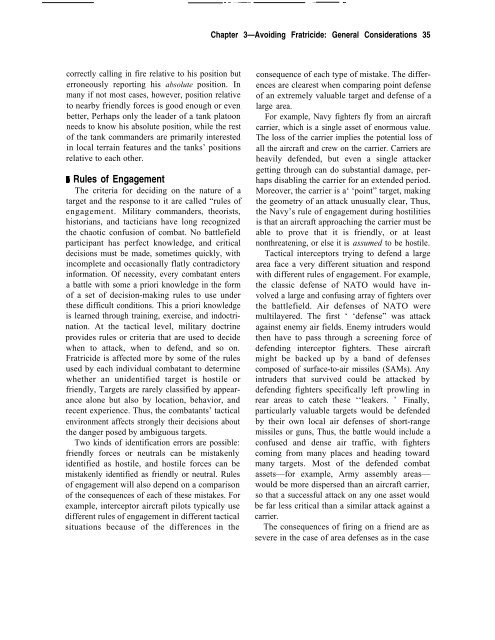Who goes there: Friend or Foe?
You also want an ePaper? Increase the reach of your titles
YUMPU automatically turns print PDFs into web optimized ePapers that Google loves.
— .— ———— -. —<br />
Chapter 3—Avoiding Fratricide: General Considerations 35<br />
c<strong>or</strong>rectly calling in fire relative to his position but<br />
erroneously rep<strong>or</strong>ting his absolute position. In<br />
many if not most cases, however, position relative<br />
to nearby friendly f<strong>or</strong>ces is good enough <strong>or</strong> even<br />
better, Perhaps only the leader of a tank platoon<br />
needs to know his absolute position, while the rest<br />
of the tank commanders are primarily interested<br />
in local terrain features and the tanks’ positions<br />
relative to each other.<br />
1 Rules of Engagement<br />
The criteria f<strong>or</strong> deciding on the nature of a<br />
target and the response to it are called “rules of<br />
engagement. Military commanders, the<strong>or</strong>ists,<br />
hist<strong>or</strong>ians, and tacticians have long recognized<br />
the chaotic confusion of combat. No battlefield<br />
participant has perfect knowledge, and critical<br />
decisions must be made, sometimes quickly, with<br />
incomplete and occasionally flatly contradict<strong>or</strong>y<br />
inf<strong>or</strong>mation. Of necessity, every combatant enters<br />
a battle with some a pri<strong>or</strong>i knowledge in the f<strong>or</strong>m<br />
of a set of decision-making rules to use under<br />
these difficult conditions. This a pri<strong>or</strong>i knowledge<br />
is learned through training, exercise, and indoctrination.<br />
At the tactical level, military doctrine<br />
provides rules <strong>or</strong> criteria that are used to decide<br />
when to attack, when to defend, and so on.<br />
Fratricide is affected m<strong>or</strong>e by some of the rules<br />
used by each individual combatant to determine<br />
whether an unidentified target is hostile <strong>or</strong><br />
friendly, Targets are rarely classified by appearance<br />
alone but also by location, behavi<strong>or</strong>, and<br />
recent experience. Thus, the combatants’ tactical<br />
environment affects strongly their decisions about<br />
the danger posed by ambiguous targets.<br />
Two kinds of identification err<strong>or</strong>s are possible:<br />
friendly f<strong>or</strong>ces <strong>or</strong> neutrals can be mistakenly<br />
identified as hostile, and hostile f<strong>or</strong>ces can be<br />
mistakenly identified as friendly <strong>or</strong> neutral. Rules<br />
of engagement will also depend on a comparison<br />
of the consequences of each of these mistakes. F<strong>or</strong><br />
example, intercept<strong>or</strong> aircraft pilots typically use<br />
different rules of engagement in different tactical<br />
situations because of the differences in the<br />
consequence of each type of mistake. The differences<br />
are clearest when comparing point defense<br />
of an extremely valuable target and defense of a<br />
large area.<br />
F<strong>or</strong> example, Navy fighters fly from an aircraft<br />
carrier, which is a single asset of en<strong>or</strong>mous value.<br />
The loss of the carrier implies the potential loss of<br />
all the aircraft and crew on the carrier. Carriers are<br />
heavily defended, but even a single attacker<br />
getting through can do substantial damage, perhaps<br />
disabling the carrier f<strong>or</strong> an extended period.<br />
M<strong>or</strong>eover, the carrier is a‘ ‘point” target, making<br />
the geometry of an attack unusually clear, Thus,<br />
the Navy’s rule of engagement during hostilities<br />
is that an aircraft approaching the carrier must be<br />
able to prove that it is friendly, <strong>or</strong> at least<br />
nonthreatening, <strong>or</strong> else it is assumed to be hostile.<br />
Tactical intercept<strong>or</strong>s trying to defend a large<br />
area face a very different situation and respond<br />
with different rules of engagement. F<strong>or</strong> example,<br />
the classic defense of NATO would have involved<br />
a large and confusing array of fighters over<br />
the battlefield. Air defenses of NATO were<br />
multilayered. The first ‘ ‘defense” was attack<br />
against enemy air fields. Enemy intruders would<br />
then have to pass through a screening f<strong>or</strong>ce of<br />
defending intercept<strong>or</strong> fighters. These aircraft<br />
might be backed up by a band of defenses<br />
composed of surface-to-air missiles (SAMs). Any<br />
intruders that survived could be attacked by<br />
defending fighters specifically left prowling in<br />
rear areas to catch these ‘‘leakers. ’ Finally,<br />
particularly valuable targets would be defended<br />
by their own local air defenses of sh<strong>or</strong>t-range<br />
missiles <strong>or</strong> guns, Thus, the battle would include a<br />
confused and dense air traffic, with fighters<br />
coming from many places and heading toward<br />
many targets. Most of the defended combat<br />
assets—f<strong>or</strong> example, Army assembly areas—<br />
would be m<strong>or</strong>e dispersed than an aircraft carrier,<br />
so that a successful attack on any one asset would<br />
be far less critical than a similar attack against a<br />
carrier.<br />
The consequences of firing on a friend are as<br />
severe in the case of area defenses as in the case



